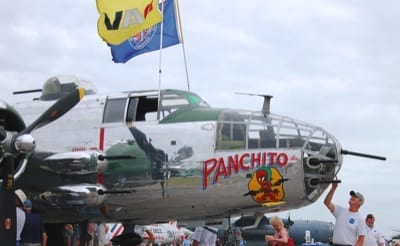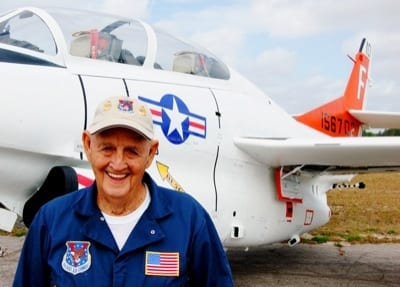The weekend wasn’t kind to the TICO Warbird Airshow. Showery weather plagued Florida’s east coast. Some complained online that warbird flying was thinner this year and a promised act didn’t appear. But for the dyed-in-wool military aviation aficionado, this was still a pure play.
Any time of year, the Valiant Air Command (VAC) offers its wares at its Space Coast Regional Airport Museum in Titusville. It’s a destination for any enthusiast, with the U.S. Astronaut Hall of Fame and Kennedy Space Center Visitors Center nearby. But for one weekend each March, it’s World War II and Cold War aircraft on the taxiways and in the air.
I’d been waiting years to see this show. Some said this year wasn’t like the 1980s, but what is? Going early before the crowds, I found a relatively broad representation of aviation technology from 1937 to recent times.
First in the static line was an FM-1 Wildcat, the 1937 fighter design that began World War II for Naval aviation. This FM-1 was one of 5,837 F4F variants built by General Motors’ Eastern Aircraft division in Linden, N.J. (GM built another 7,546 TBM torpedo bombers in my New Jersey hometown. As a child, I saw World War II’s derelicts on the TTN ramp — a first and indelible aviation memory.)

Next, there were rare Korean-era/1950s classics, including the Navy F9F Panther jet and an Air Force H-19 Sikorsky piston-engined transport helicopter. Such 1950s hardware was pioneering. And certainly the F4F Wildcat was a technological leap in 1937, starting out as a biplane only to morph into a tough-as-nails monoplane.
VAC’s particular Wildcat was itself singularly historic, having been fished out of Lake Michigan after 50 years. You read about it — the conversion of Great Lakes steamers into aircraft carriers for training, the novice aviators learning their “traps” off the Chicago lakefront. VAC’s FM-1 had one wing retracted to show off its folding wing and landing gear complexities. Surprisingly, “bicycle chains” were involved, just like the Beech 99 landing gear we used to chuckle about at Allegheny Commuter.
If the TICO show was diminished from its heyday, VAC members attending each aircraft were still among the best representatives I’ve found at a show. At the Wildcat, I was invited to consider its remarkably sparse instrument panel. American seat-of-the pants flying skills and tactics were certainly predominant as this old design took on the superior Japanese Zero.
Up the line, there was even a woefully worn 1954 Fairchild C-123 Provider in restoration by the Air America Foundation. (Remember that movie?) Uniquely, this one had escaped a hurried scrapping in Central America after the Iran Contra adventure of the Reagan years. (You read about that one, too, and the C-123’s role in it.) And there was much, much more to contemplate in the technology, history and international politics represented by these airframes.
 The Valiant Air Command preserves the artifacts of aviation’s key World War II and post-war periods. Here, you can see how new concepts emerged and new challenges were met. Along with the hardware, dedicated VAC members like Dick Mercer (pictured above) could inspire the visitor with his productive career in aviation as well as the Navy T-2 jet trainer next to him. At a 1980-vintage Navy T-34C turboprop trainer, I could compare notes with a knowledgeable pilot about original piston-engine T-34s back to their 1948 derivation from the Beech Bonanza.
The Valiant Air Command preserves the artifacts of aviation’s key World War II and post-war periods. Here, you can see how new concepts emerged and new challenges were met. Along with the hardware, dedicated VAC members like Dick Mercer (pictured above) could inspire the visitor with his productive career in aviation as well as the Navy T-2 jet trainer next to him. At a 1980-vintage Navy T-34C turboprop trainer, I could compare notes with a knowledgeable pilot about original piston-engine T-34s back to their 1948 derivation from the Beech Bonanza.
I also saw several signs of tougher times for non-profits like VAC. Not only was there a charge to sit in one of these classics (a rare privilege) but a $3 fee to photograph some cockpits. Similarly, VAC warned off wannabes and hangers-on who would abuse media passes to avoid paying admission. Times are tough. Costs are sky-high. And these guys and gals are struggling to preserve our aviation heritage.
Off-putting? Sure, but only for those remembering easier days. Today, it’s a wake-up call to visit and support our aviation museums. If they’re good, like Valiant Air Command, you’re going to learn something you didn’t know.
Photo and Story © 2012 Drew Steketee All Rights Reserved
People who read this article also read articles on airparks, airshow, airshows, avgas, aviation fuel, aviation news, aircraft owner, avionics, buy a plane, FAA, fly-in, flying, general aviation, learn to fly, pilots, Light-Sport Aircraft, LSA, and Sport Pilot.
